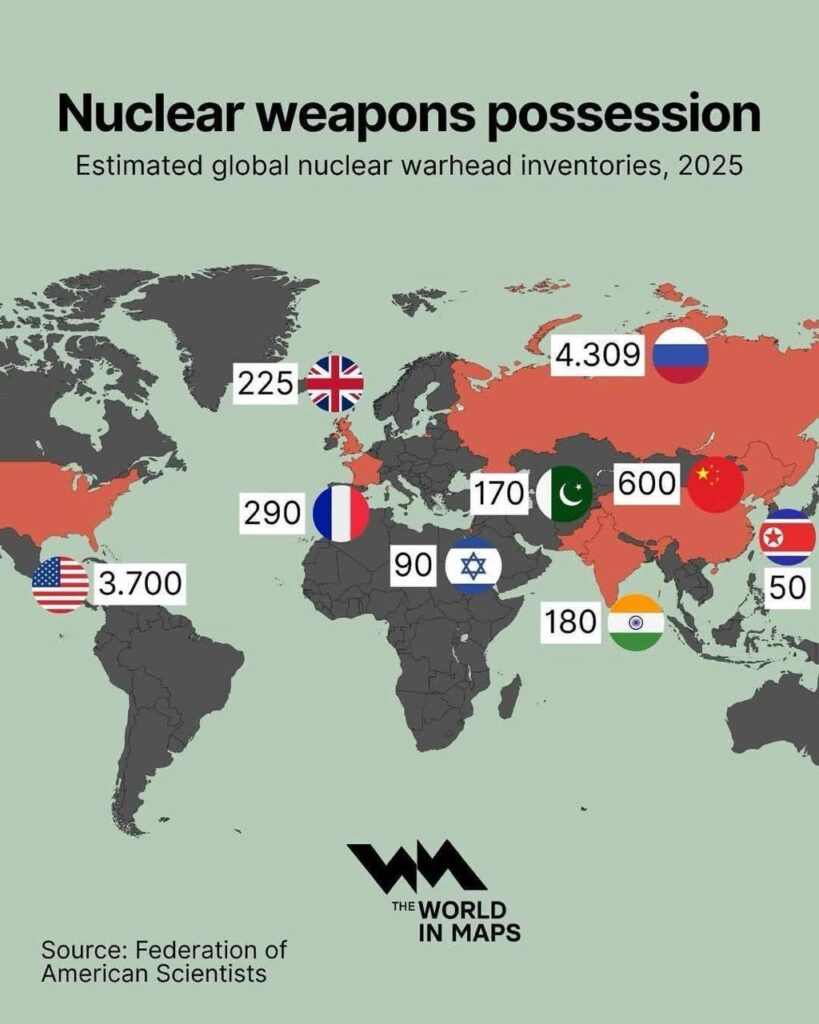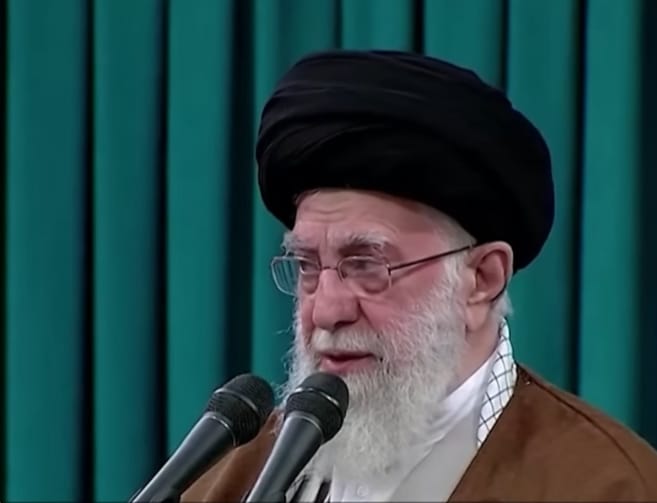

The West’s double standards, the crumbling NPT, and the defiance of a besieged nation
A World Armed, A Nation Accused
The Federation of American Scientists (The World in Maps) paints a stark picture of global nuclear disparity.
As of 2025, only nine countries possess nuclear weapons. At the top of the list are Russia (4,309) and the United States (3,700), followed by China (600), France (290), UK (225), Pakistan (170), India (180), Israel (90), and North Korea (50).
Notably absent is Iran, yet it remains the focal point of alarmist rhetoric about global nuclear threats—chiefly propagated by Israel and the United States. This contradiction demands closer scrutiny: why is a non-nuclear Iran consistently portrayed as a threat, while countries with hundreds or thousands of warheads are normalized?
The Historical Context: What Is the NPT?
The Nuclear Non-Proliferation Treaty (NPT), signed in 1968 and effective from 1970, was designed to prevent the spread of nuclear weapons and encourage disarmament. Its three pillars are:
1. Non-proliferation: Preventing the spread of nuclear weapons.
2. Disarmament: Promoting the elimination of existing arsenals.
3. Peaceful use of nuclear technology: Supporting nuclear energy for development under international safeguards.
Iran is a signatory to the NPT, unlike Israel, which has never officially declared its nuclear arsenal nor subjected it to international inspection. Iran’s nuclear programme—monitored by the International Atomic Energy Agency (IAEA)—has remained under intense global scrutiny despite zero evidence of weaponization.
Iran’s Nuclear Programme: Myths vs. Facts
Iran has repeatedly insisted that its nuclear programme is for peaceful energy generation, a claim bolstered by IAEA inspections over decades. According to IAEA Chief Rafael Grossi, in his recent CNN interview with Fareed Zakaria, “IAEA did not find elements to prove that Iran had a plan toward a nuclear weapon. We report what we see; we do not speculate.”
This statement came in the immediate aftermath of the U.S. aerial strike on three Iranian nuclear installations, a move that Grossi condemned as a blatant attack on the integrity of the NPT and IAEA’s authority.
The IAEA’s voice of reason was drowned by the political drumbeat of Israeli and American leaders. Their justification for the attack hinged on the old, unsubstantiated narrative that Iran was “days away” from building a bomb. Yet, no new evidence has surfaced to validate this claim. The attack, therefore, violates international law, weakens the legitimacy of the NPT, and endangers the delicate nuclear equilibrium of the Middle East.
America and Israel: Rogue Enforcers of a Broken Order
The latest military action exposes the deep hypocrisy of the American and Israeli positions. Both countries are nuclear-armed, neither faces meaningful scrutiny for their arsenals, and yet both feel justified in bombing a non-nuclear state under international monitoring.
President Trump’s declaration that the Iranian nuclear programme had been “obliterated” by U.S. Bunker Buster bombs is, in fact, an exaggerated claim. Iran immediately dismissed this rhetoric, noting that the evacuation of enriched materials and personnel had been completed in anticipation of the strike.
According to a New York Times report, satellite analysis showed that Iran’s Fordow enrichment facility—deep inside a mountain—sustained external damage but survived the attack. Eyewitness accounts from Armenia, where convoys were reportedly seen carrying equipment and material from Iran, further corroborated Tehran’s preparedness.
The Defiant Republic: Cornered but Unyielding
Iran has suffered significant infrastructural losses in the past ten days. Yet, the country is not bowing to pressure. If anything, its resolve is hardening. Years of adhering to the NPT, only to be attacked and vilified, may have convinced Iranian leadership that compliance offers no protection.
The idea that Iran can be bombed into submission is increasingly being seen as a pipe dream. Despite suffering economically and militarily, Iran remains strategically capable, regionally networked, and domestically resilient.
Its retort to Trump’s ultimatum was more than symbolic. It demonstrated strategic foresight, logistical agility, and a clear message: Iran will not be bullied into giving up its right to sovereign technological advancement.
What Next? A Nuclear-Iran or an Exploded Treaty?
Iran has so far resisted the temptation to withdraw from the NPT. But that may change. As international law collapses under the weight of superpower aggression, Iran could very well exit the treaty and embark on a weaponization path.
A Russian presidential aide has already hinted that Moscow might be willing to supply nuclear warheads to Iran in the event of U.S.-led escalation. If this materialises, the balance of power in West Asia—and indeed the world—will be irreversibly altered.
This is not mere speculation. It reflects the crumbling credibility of non-proliferation as a principle. When laws are enforced selectively, and watchdogs are undermined, the incentives for restraint disappear.
Who Threatens World Peace?
The map shared by The World in Maps tells a powerful truth. Iran has no nuclear warheads. The countries that do—America, Israel, and their allies—are the ones invoking fear and bombing others under flimsy pretences. This is not just hypocrisy; it’s nuclear colonialism.
If the NPT is to survive, it must be enforced fairly and globally. Until then, Iran’s defiance is not just understandable—it may be the only path left for its survival.
Whether or not Iran chooses the nuclear path, one thing is certain: its nuclear mission may be delayed, but not derailed. As long as global nuclear apartheid persists, the dream of disarmament remains a cruel illusion.
Hasnain Naqvi is a former member of the history faculty at St. Xavier’s College, Mumbai



